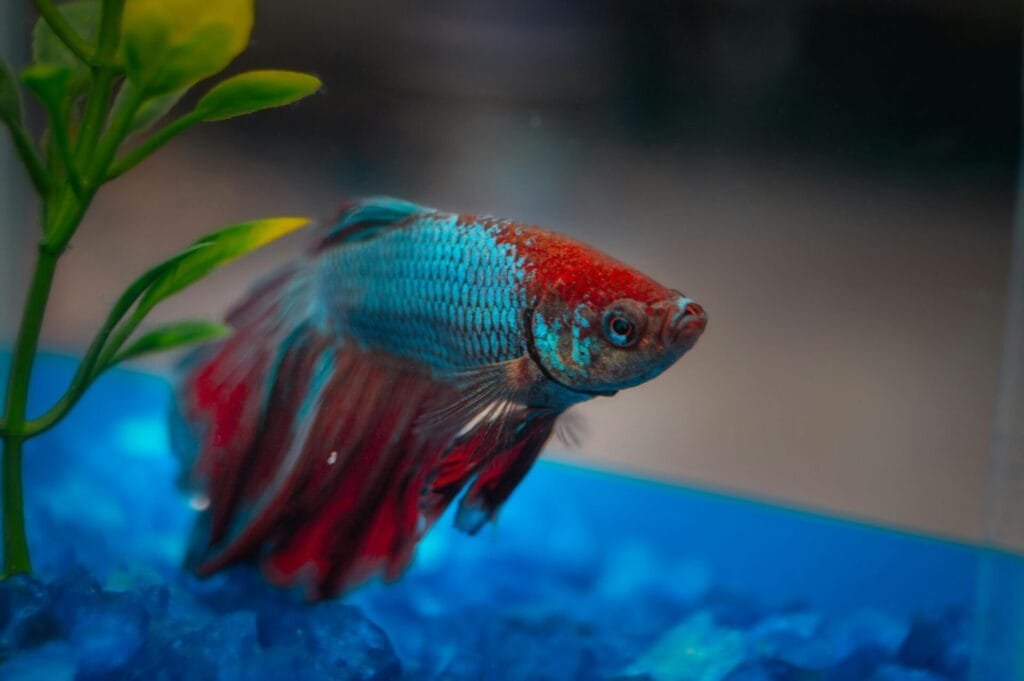Have you ever wondered if betta fish have teeth? The answer may surprise you! Betta fish do indeed have teeth, although they are incredibly tiny and often go unnoticed. These miniature teeth play a vital role in the betta fish’s feeding and defense mechanisms.
When it comes to their dental structure, the teeth of betta fish are primarily located on their lower jaw. They are adapted for surface feeding and catching prey, making them well-equipped for their natural habitat. Despite their small size, these teeth are essential for the betta fish’s survival.
Curious to know more about how to spot betta fish teeth, their functions, and their dental care? Stay tuned as we dive deeper into the fascinating world of betta fish dental anatomy.
How to Spot Betta Fish Teeth
Spotting betta fish teeth can be challenging due to their small size. These teeth are almost invisible to the naked eye, requiring a closer look for better observation. To get a detailed view of betta fish teeth, enthusiasts can use a magnifying glass or a camera’s macro zoom lens.
With the aid of a magnifying glass or camera’s macro zoom lens, you can capture close-up images of a betta fish’s open mouth. This allows for a better examination of their teeth, which are often represented by white specks.
By using these tools, you can uncover the hidden teeth of a betta fish and gain a deeper understanding of their dental structure and features.
Do Betta Fish Have Teeth? The Function of Betta Fish Teeth
Betta fish are equipped with teeth that serve two essential functions – feeding and defense. These tiny teeth, although barely visible to the naked eye, play a crucial role in the betta fish’s survival.
One of the primary purposes of betta fish teeth is for feeding. The unique upturned mouth design, combined with these teeth, allows bettas to excel at surface feeding. They are skilled at catching prey that floats or swims close to the water surface, such as insects and small crustaceans.
The function of betta fish teeth extends beyond feeding. These teeth also serve as a defense mechanism. When perceiving a threat, bettas can use their teeth to bite and deter potential aggressors. This ability to defend themselves showcases their adaptability and resourcefulness in the face of danger.
Overall, the function of betta fish teeth is multifaceted, enabling them to excel at both feeding and self-defense. Their teeth, combined with their unique mouth structure, make them well-suited for surface feeding and provide them with a means to protect themselves in their natural habitat.
Feeding Adaptations of Betta Fish
| Adaptation | Description |
|---|---|
| Upturned mouth | Allows bettas to feed on prey near the water surface. |
| Teeth | Aids in grasping and securing prey during feeding. |
| Surface feeding | Bettas have evolved to specialize in catching prey that floats or swims close to the water surface. |
Betta Fish Behavior: Biting and Aggression
While betta fish are not notorious biters, they can exhibit biting behavior under certain circumstances. Betta fish are generally solitary creatures and can become territorial if housed with other bettas. This territoriality can lead to occasional nipping and biting. To prevent biting incidents, it is important to provide bettas with a peaceful and appropriate tank environment, understanding their needs, and considering their housing arrangements.
The Territorial Behavior of Betta Fish
One of the key factors behind biting behavior in betta fish is their territorial nature. Betta fish are native to the shallow waters of Southeast Asia, where they establish territories to defend against intruders. In an aquarium setting, bettas may display aggression towards other fish, including their own species. This aggression can manifest as biting, flaring of fins, and chasing.
Preventing Biting Incidents
Creating a suitable environment for betta fish is essential in minimizing biting incidents. Here are some tips to help you prevent aggression and biting behavior:
- Provide Adequate Space: Ensure that the tank is large enough to accommodate the betta fish comfortably and limit their exposure to other fish.
- Avoid Overcrowding: Keep bettas in separate tanks or provide sufficient hiding spots and visual barriers to reduce stress and territorial disputes.
- Adjust Tank Setup: Create a well-planted aquarium with appropriate hiding places, such as caves or dense vegetation, to provide areas for bettas to establish their territories.
- Monitor Feeding: Feed bettas separately and avoid overfeeding, as competition for food can trigger aggression.
- Observe Behavior: Regularly observe betta fish for signs of stress or aggression, and be prepared to separate them if necessary.
Taking these precautions and ensuring a calm and stress-free living environment can help maintain peace among betta fish and prevent biting incidents.
| Behavior | Description |
|---|---|
| Flaring Fins | Occurs when bettas extend and display their fins to intimidate perceived threats. |
| Nipping | Bettas may nip at the fins or tails of other fish as a display of dominance or aggression. |
| Biting | Occasional biting incidents may happen when bettas feel threatened, invaded, or provoked. |
Betta fish behavior is influenced by their instincts and natural tendencies. Providing them with a well-maintained and suitable environment can mitigate biting and aggression, ensuring a harmonious aquarium for these captivating aquatic creatures.
Dental Care for Betta Fish
Proper dental care is essential for maintaining the oral hygiene and overall health of betta fish. While these tiny teeth have a self-cleaning mechanism, it is crucial to create an environment that promotes optimal dental health.
Maintaining Water Quality
One of the key factors in betta fish dental care is ensuring optimal water conditions. Poor water quality can lead to infections that can directly impact their teeth. Regular monitoring of tank water parameters such as temperature, pH levels, and ammonia levels is necessary to prevent the development of dental issues. Consistent water changes and the use of a reliable water conditioner are vital to maintain a clean and healthy environment for your betta fish.
Providing a Balanced Diet
A proper diet is essential for the oral health of betta fish. A balanced diet that mimics their natural feeding habits supports their dental care. Include a variety of high-quality betta fish pellets, freeze-dried or frozen foods like bloodworms, brine shrimp, and daphnia, as well as occasional treats like live food. The act of chewing on these foods stimulates the betta’s teeth and helps prevent the buildup of plaque or food particles.
Cleansing Artificial Decor
In addition to maintaining water quality and providing a balanced diet, ensuring clean artificial decor in the tank is essential. Artificial plants, rocks, and other tank decorations can accumulate algae, bacteria, and debris, which may lead to oral infections in betta fish. Regular cleaning of these items with an aquarium-safe brush or sponge helps prevent the build-up of harmful substances and promotes oral hygiene.
By implementing these dental care practices, you can ensure that your betta fish enjoys good oral health and overall well-being.
| Care Tips for Betta Fish Dental Health | Details |
|---|---|
| Maintain optimal water conditions | Regularly monitor and maintain water parameters such as temperature, pH levels, and ammonia levels. |
| Provide a balanced diet | Include high-quality betta fish pellets, freeze-dried or frozen foods, and occasional treats to promote healthy chewing. |
| Clean artificial decor | Regularly clean artificial plants, rocks, and tank decorations to prevent the build-up of harmful substances. |
Can Betta Fish Bite Humans?
Betta fish have tiny teeth that enable them to bite, although their bites are not harmful to humans. Unlike other aggressive fish species, bettas generally have a non-aggressive nature towards humans, and their bites feel more like gentle nibbles. It is essential to differentiate between biting and nipping behaviors in betta fish.
Biting is a defensive action primarily triggered by stress or fear, whereas nipping is often associated with curiosity or exploration. If a betta fish feels threatened or if it perceives a stressful situation, it may exhibit biting behavior. However, it’s crucial to note that the likelihood of a betta fish biting a human is relatively low.
Betta fish are naturally accustomed to their own territory and typically do not perceive humans as threats. They commonly interact with humans during feeding, tank maintenance, or other routine activities without exhibiting any signs of aggression or territorial behavior.
If you are concerned about being bitten by a betta fish, it is advisable to handle them carefully and maintain a calm and peaceful environment around their tank. By keeping the fish stress-free and providing them with an appropriate habitat, the risk of biting incidents can be minimized.
How to handle a betta fish:
- Use a net or cup to gently transfer the fish if necessary, avoiding direct contact with your hands.
- Avoid sudden movements or loud noises that may startle the fish.
- Wash your hands thoroughly before placing them into the tank to avoid introducing chemicals or contaminants.
- Keep other tank inhabitants compatible with betta fish to prevent any aggressive interactions.
Encouraging peaceful interactions with your betta fish can help cultivate a rewarding and enjoyable pet ownership experience. Remember, a betta’s bite is usually harmless and more of a curious behavior than an aggressive one.
| Betta Fish Biting Behavior | Description |
|---|---|
| Defensive Biting | Betta fish may exhibit biting behavior as a defensive action when feeling threatened or stressed. |
| Territorial Behavior | Betas can display territorial behavior, but it is primarily directed towards other bettas and rarely towards humans. |
| Avoidance of Aggression | By providing a calm and suitable tank environment, betta fish aggression towards humans can be minimized or avoided. |
As responsible pet owners, it is important to respect the natural behaviors and instincts of our betta fish. Understanding their tendencies and providing them with a stress-free environment ensures a harmonious and enjoyable coexistence.
The Dental Journey of Betta Fish: From Embryonic Development to Adult Teeth
The dental journey of betta fish begins during their embryonic development, where they start to form their specialized teeth, known as pharyngeal teeth. These teeth play a crucial role in their feeding and digestion process.
Unlike humans, betta fish do not have baby teeth that are replaced by permanent teeth. Instead, their dental structure evolves and matures as they grow from eggs to fry and into adult fish. This continuous development ensures that their teeth are well-suited for their changing dietary needs and feeding habits.
During this development process, betta fish experience significant growth and changes in their dental anatomy. The size and shape of their teeth adapt to support their evolving diet and feeding behavior. The development of their teeth is a remarkable adaptation that enables betta fish to thrive in their natural environment.
Adult Betta Fish Dental Structure
When betta fish reach adulthood, their dental structure is fully formed and optimized for their specific needs. The pharyngeal teeth, located in the back of their throat, help them grip and chew food efficiently.
These teeth are small and numerous, aiding in the consumption of various types of prey, including live foods and pellets. The arrangement of their teeth allows betta fish to effectively catch, chew, and process their food, ensuring proper nutrition and digestion.
Here is a table summarizing the dental features and growth stages of betta fish:
| Development Stage | Description |
|---|---|
| Embryonic Development | Formation of pharyngeal teeth begins. |
| Egg to Fry | Teeth continue to grow and adapt to changing needs. |
| Adult Fish | Full development of pharyngeal teeth optimized for feeding. |
Overall, the dental journey of betta fish is a fascinating process that showcases the intricacies of their adaptation and survival. Understanding the growth and development of their teeth provides valuable insights into their dietary needs and oral health.
Conclusion
The dental anatomy of betta fish reveals fascinating features that contribute to their unique oral structure. Although their teeth are tiny, they play a crucial role in their feeding and defense mechanisms. Spotting these small dental structures may require the aid of tools like a magnifying glass or a camera’s macro zoom lens, showcasing the intricacies of their dental anatomy.
Providing proper dental care for betta fish is essential for their overall health and well-being. This includes maintaining optimal water conditions in their tank, which helps prevent infections and ensures healthy teeth. Additionally, offering a diet that mimics their natural feeding habits supports their dental health and function.
While betta fish can bite, their bites are usually mild and non-harmful. Understanding the dental journey of these fascinating creatures, from their embryonic development to the maturity of their teeth, enhances our appreciation for their uniqueness. By delving into the betta fish dental anatomy, dental features, and tooth structure, we gain a deeper understanding of their oral anatomy and its significance in their existence.


